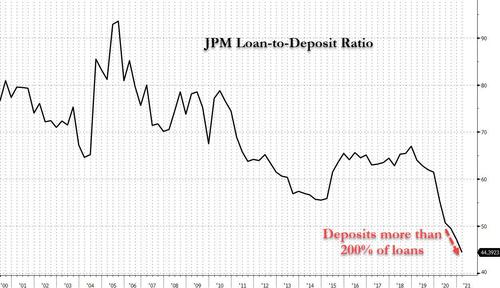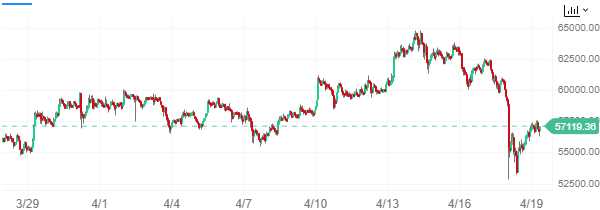 How is this a good thing?
How is this a good thing?
Clearly, it's not. Money is simply not being spent in our Economy and that's not the sign of a healthy economy. Of course, we've been heading this way for two decades now back from the 90s, where $1 earned would circulate through the economy and average of 2.2 times, generating 3.2 GDP Dollars. Now the velocity of money is getting close to 1, meaning a Dollar earned only adds one more Dollar to the GDP, for 2 GDP Dollars.
What does that mean? Well it means that you $10Tn in circulation to have a $20Tn GDP where you used to need $6.25 so 60% more Dollars are needed to create a Dollar in GDP these days. That means the Fed's policies are 60% less effective and that the economy grows 60% slower – for now. It also means that, if for some reason, the pace of borrowing and spending pick up, that we could easily send prices rising 100% from where they are now, as money speeds up again. That would, of course, boost our GDP (so yay!) but it would do so in a hyperiflationary way.
In the 1990s, to keep inflation under 3%, the Fed raised rates from 3% to 6.5% and in 1978-1980, the Inflation Rate in the US was 9%, 13.3% and 12.5% and the Fed Funds rate was 10%, 12% and yes – 18% in 1980. That's what the Fed has to do to keep a lid on inflation but that tool is no longer available to the Fed since we are now $28Tn in debt and 18% of $28Tn is another $5Tn we simply do not have so this country would become Greece and suffer a massive meltdown if we tried to use the Fed Funds rate to control inflation.
 Well, that's a pretty serious problem because look at this other indicator: The Loan to Deposit ratio has also collapsed, meaning banks are no longer making money lending it to people – which is kind of the whole purpose of banks. Instead they make money gambling in stocks and derivatives – just like they were doing before the last banking crisis.
Well, that's a pretty serious problem because look at this other indicator: The Loan to Deposit ratio has also collapsed, meaning banks are no longer making money lending it to people – which is kind of the whole purpose of banks. Instead they make money gambling in stocks and derivatives – just like they were doing before the last banking crisis.
One of the reasons for this is that the Rich, the Top 0.1%, whose wealth begins at $16M per household, have become so rich that they simply don't need to borrow money anymore and, also, they have nothing left to buy so they don't contribute to the GDP – they simply suck all the money (and fun) out of the economy with their massives, static deposits and, since we don't tax them, the money is permanantly removed from the economy and the Fed has to constantly print more of it just to get some into the bottom 99% which, of course, mostly ends up in the hands of the wealth – further increasing the wealth gap.
This unfun way to make The Rich richer is then reflected in the lack of business activitiy, since consumer spending by the bottom 99% is 60% of the US economy and that then is reflecting in the historically low Earnings Yield of 2.36% by S&P 500 companies, with 6% being "normal". This isn't just the virus either because we haven't seen 6% more than a couple of ticks in the past 20 years but 2.36% is downright scary – especially for a market that commands record-high prices for those earnings – 35x those earnings at last count.

 We are throwing money at this problem and the money certainly isn't working. It's about as effective as giving people paper towels to help them recover from record-breaking flood damage – what kind of psychopath does that? The flood of money in the economy is not getting the economy wet – it's still running dry and the Fed is flooring it with rates near 0% and they can try paying you to borrow money but if you think we're misspending Trillions of newly printed Dollars now – wait until you see the waste generated if they pay Corporations to buy back their own stock!
We are throwing money at this problem and the money certainly isn't working. It's about as effective as giving people paper towels to help them recover from record-breaking flood damage – what kind of psychopath does that? The flood of money in the economy is not getting the economy wet – it's still running dry and the Fed is flooring it with rates near 0% and they can try paying you to borrow money but if you think we're misspending Trillions of newly printed Dollars now – wait until you see the waste generated if they pay Corporations to buy back their own stock!
This all could be good for the market but bad for the people. The Fed's back is against the wall and the Dollar is down another half a point this morning and on the way back to the December lows of 90 but bouncing there against a backdrop of weak Q1 earnings could lead us to have a correction that looks a little like Bitcoin this weekend – another ridiculous bubble caused by this ridiculous misallocation of Capital Assets – down 10% in 10 days and now testing the strong bounce line at $58,000:

It's a very light week for Econmic Data with literally nothing of note until Wednesday's 20-Year Bond Auction and then Thursday it's Chicaga & KC Fed Reports along with Leading Economic Indicators and Existing Home Sales with New Home Sales and PMI on Friday. That puts the spotlight squarely on earnings and we'll see if the average US company can manage to make back more than 2.36% of what you pay for their stock this quarter:




